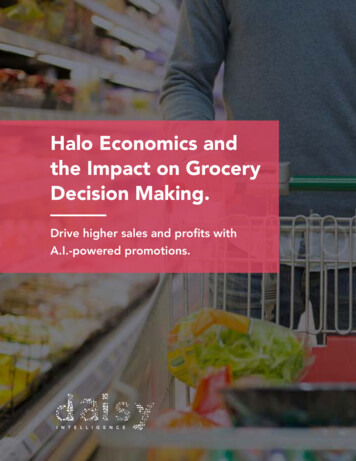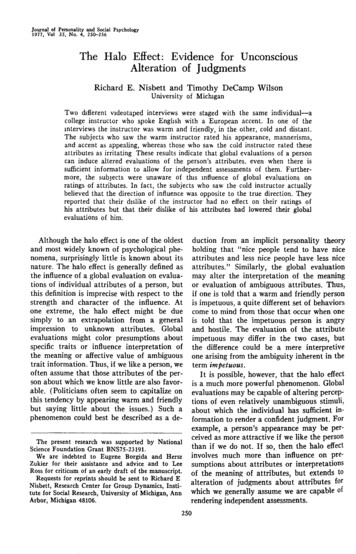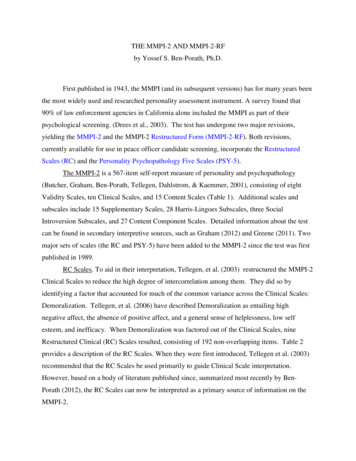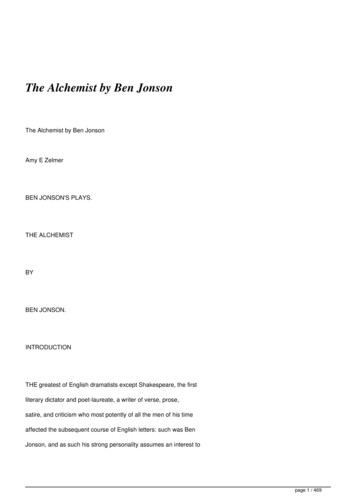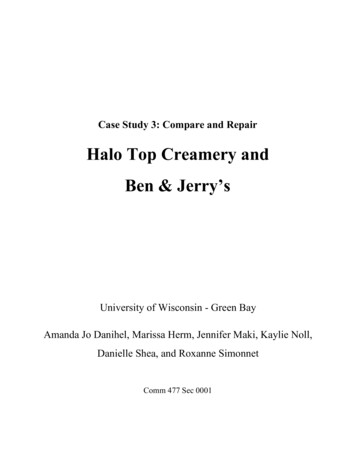
Transcription
Case Study 3: Compare and RepairHalo Top Creamery andBen & Jerry’sUniversity of Wisconsin - Green BayAmanda Jo Danihel, Marissa Herm, Jennifer Maki, Kaylie Noll,Danielle Shea, and Roxanne SimonnetComm 477 Sec 0001
1Table of ContentsExecutive Summary 2Introduction .3Brief Company Overviews .3Halo Top .3Ben & Jerry’s .4Goals and Strategies 5Halo Top .5Ben & Jerry’s .7Platform Analysis 9Research Method .9Active/Passive Platforms .9Facebook 10Instagram 12Twitter 17Pinterest .20YouTube .22Websites .26Network Analysis .27Overall Evaluation and Comparison .29Repairs .37Rejected Solutions .39So What? .40Conclusion .40Appendices .42References .69
2Executive SummaryOur group analyzed two ice cream brands and their social media platforms in order toevaluate each company’s strategy, then make the necessary repairs to their social media plans.The two ice cream brands include Halo Top and Ben & Jerry’s. We researched each of thesecompanies and their backgrounds to determine their goals and strategies, then compare thesewith their utilization of social media. The platforms we analyzed consisted of Facebook,Instagram, Twitter, Pinterest, and YouTube, with the addition of an examination each company’swebsite. We conducted our research within a two month period, and created graphs and charts todepict important findings from our research. These findings included engagement trends, postingpatterns, and categorical analyses. These pieces of information, along with our connectionsmatrix and network analysis, helped us further evaluate each company’s presence on socialmedia in more detail. After reviewing each platform individually, using channel-specificevaluation tools to grade both Halo Top and Ben & Jerry’s, we created a more broad evaluationtool to review each company as a whole. The 5 C’s of Social Media, which consists ofCoordinates, Content, Channels, Connections, and Corrections, was a key source of informationthat helped us outline our evaluation tool. These results led us to find the holes in each of theirstrategies, and therefore come up with thorough points to repair them. By being able to note thedifferences in the portrayal of each brand, we are able to create a more comprehensive plan forthese companies going forward. Overall, this case study uncovered the fact that social mediaeffectiveness, as well as alignment and connection with goals and strategies, is crucial toimprovement and growth within a company.
3IntroductionIn the following case study, we were instructed to first, compare the social mediapresence of two competing brands, and second, prepare recommendations for repairs for eachbrand’s social media. We chose to compare and repair the social media of two competitors in theice cream industry: Halo Top Creamery and Ben & Jerry’s. In order to do so, we reviewed eachbrand’s social media presence across multiple platforms for a two month period. From thisexamination and analysis, we then were able to evaluate their effectiveness, based on theevaluation tools we crafted. Depending on the results of this evaluation, we developedsuggestions for repairs that we feel would enhance each brand’s social media strategy.Brief Company OverviewsHalo TopHalo Top Creamery is a relatively new ice cream brand that specializes in low calorie,low sugar and high protein ice cream. It was founded by former lawyer, Justin Woolverton, whocame up with the idea because of his hypoglycemic diet restrictions (Calderone, 2017). It startedout as Woolverton experimenting in his own kitchen to make ice cream for himself, and theneventually expanded into the rapidly growing company it is today. It started by selling ice creamin Los Angeles, before expanding across the United States, and even into other countries, such asAustralia and Singapore. Currently, Halo Top only offers about 17 flavors (Calderone, 2017).However, having more limited flavor options hasn’t hindered sales. Halo Top’s sales haverecently surpassed more established competitors, such as Ben & Jerry’s and Haagen-Dazs(Calderone, 2017). It has quickly built a cult-like following and gained the support of notable
4celebrities such as Brie Larson and Karlie Kloss (Calderone, 2017). This following has been builtup through word of mouth and social media, rather than traditional forms of advertising.Woolverton has publicly explained that his strategy is to promote the brand primarily throughsocial media, because he believes it is the most cost-effective and authentic way to reachcustomers (Liffreing, 2017). The social media accounts are managed by an in-house team, topreserve what Woolverton feels is their most authentic and original brand voice (Liffreing,2017).Ben & Jerry’sBen & Jerry’s is one of the most highly recognized ice cream brands in America. It wasfounded in 1978 by Ben Cohen and Jerry Greenfield, who had originally wanted to start a bagelcompany, but settled for ice cream because the equipment was cheaper. They opened their firstice cream shop in a renovated gas station in Burlington, Vermont, and from there, the companycontinued to grow. Today, Ben & Jerry’s operates 577 stores and services 38 countries ("FastFacts," n.d.). Its growth lead to it being purchased by Unilever for 326 million in 2000 ("2016Social," n.d.). However, through it all, the brand has never lost sight of its mission to not onlysell good ice cream, but also to practice and promote social responsibility. In 2012, Ben &Jerry’s became the first wholly owned subsidiary to gain B-corp certification ("2016 Social,"n.d.). Basically, this certification means that Ben & Jerry’s “uses the power of business to solvesocial and environmental problems”("2016 Social," n.d.). Ben & Jerry’s makes a point to expressand honor this commitment through both actions and words, and this is also evident in theirsocial media presence. Their social media accounts, which are managed by an in house socialmedia team, have garnered attention by experts. According to a 2016 report by social media
5analytics platform NetBase, Ben & Jerry’s has the best social media presence of any U.S.restaurant chain. Not only did Ben & Jerry’s place first, but the brand did so by a fairly widemargin: 5,627 mentions per dollar in sales. That’s 39% higher than second-place Chipotle’sscore and nearly double than that of Starbucks (O'Brien, 2016). Ben & Jerry’s notoriety as abrand, and now as a voice on social media, only helps to enhance their position in the industry.Goals and StrategiesHalo TopBefore assessing each brand’s social media presence, we felt it was first important toidentify each company’s business goals, social media goals, and overall intended social mediastrategies. When it came to Halo Top’s business goals, we felt they were fairly obvious. First,Halo Top wants to promote healthy ice cream. The company can only be profitable if it sellsenough of its product, and the fact that their ice cream is more health-conscious is the uniqueselling point of Halo Top’s product. Second, Halo Top wants to beat their less health-consciouscompetitors. This is evident on their website, when they directly compare their product tocompetitors such as Haagen-Dazs and Ben & Jerry’s. Third, relating back to the first goal, HaloTop wants to make a profit. This is a pretty self-explanatory business goal of any for-profitorganization. A fourth business goal that Halo Top has is to maximize their advertising budget.Woolverton, Halo Top’s CEO, has said publicly that one of the reasons Halo Top is active onsocial media, but does not often advertise on traditional media, is because he feels social media ismore cost-effective.
6Based on these business goals as well as our research, we were able to identify HaloTop’s social media goals. Woolverton has also said publicly that he has chosen to promote HaloTop on social media because he feels it keeps the brand more authentic and true to a “smallbusiness feel”. Maintaining this brand identity is one of their goals. Another social media goalfor Halo Top is to reach consumers who have specific dietary concerns. As mentioned before,Halo Top was designed with this consumer in mind, because they offer low-sugar, vegan andgluten free options. Social media is the main way they attempt to reach these specific people, andhopefully convert them into Halo Top fans. In addition to targeting those with specific dietaryrestrictions, another goal of Halo Top is to target millennials. This is evident through their trendyposts, which reference topics such as the TV show Friends , Pokemon Go, and Harry Potter, aswell as their ability to capitalize on other popular social media trends, such as memes. HaloTop’s fourth social media goal is to create an environment where two-way communication canhappen. Instead of just pushing out their own content and not interacting, Halo Top activelyshares, likes, and comments on other user’s content. This enables fans and followers to feel asthough they are not only interacting with the brand, but also building a relationship.Based on the aforementioned business goals and social media goals, as well as our ownresearch, we were able to infer Halo Top’s current social media strategies. Their responsestrategy is to respond in fresh, original ways to each person. We noticed that on social media,Halo Top replies to user comments uniquely almost every time, rather than using a template orautomated response. This relates back to their goal of building relationships and creatingtwo-way communication, because this more organic response strategy is more conducive tomaking customers feel connected to and valued by the brand. As mentioned previously, another
7social media strategy of Halo Top’s is to use trends to promote their brand. They tie theirproducts into trendy pop culture themes whenever possible. A third social media strategy HaloTop holds is to leverage social media rather than traditional media for promotion. Again, thepurpose of this is to maximize budget, effectively reach their target audience, and maintain anauthentic brand voice. One of the unique social media strategies leveraged by Halo Top is to usemore user-generated content than content created by the brand. On many of the major socialmedia platforms, Halo Top actually shares other users’ content more frequently than postingtheir own.Ben & Jerry’sBen & Jerry’s business goals were fairly easy to identify, as they are clearly stated ontheir website. Ben & Jerry’s identifies three major business goals in the form of categorizedmissions. They are as follows: Product mission: make good ice cream Economic mission: make money Social mission: be innovative/make the world a better placeBen & Jerry’s social media goals were not clearly articulated anywhere, and so wecombined our research with our social media analysis to make inferences. We identified one oftheir main social media goals was to promote brand identity, rather than simply pushingproducts. Because Ben & Jerry’s is well established and recognizable, they are now spendingmore time on informing the public of who they are as a brand, rather than simply the productsthey offer. As a certified B-Corporation, Ben & Jerry’s also has the the unique (for an ice creamcompany) social media goal of using their brand as a platform for social causes, social awareness
8and social responsibility. Because Ben & Jerry’s has this unique classification, they have legallyestablished their organization’s dedication to advancing social causes, and this is evident in theirsocial media presence. Through this goal, Ben & Jerry’s is looking for more than just interactionon social media, but they are also aspiring to a higher call of action, such as raising money forsocial issues, and motivating people to take action against social injustice. One of Ben & Jerry’starget audiences, in addition to ice cream lovers, is audiences with similar political and societalbeliefs. Ben & Jerry’s makes it a goal to reach these like-minded people and build a community.However, just because Ben & Jerry’s makes it a priority to advance social causes, does not meanthey have abandoned their product. They do also have a social media goal of informing theirfollowers of new products, and various brand announcements. This includes posts about newflavors, or partnerships with Jimmy Fallon.Based on our research and social media analysis, we were able to make inferences aboutthe social media strategies currently leveraged by Ben & Jerry’s. Their response strategy appearsto be to format responses based on a template and to redirect customers to anothercommunication channel. When reviewing past responses, we noticed that Ben & Jerry’sresponses were not automated, but many of them were very similar, suggesting that a template ofsuggested wording is used repeatedly, and then only the details are changed. Also, many of theresponses suggested customers call customer service, or fill out a form on the website, ratherthan directly addressing the response right on social media. Another strategy currently used byBen & Jerry’s is to specifically use videos for new flavor announcements. This seemed to be arepeated method of sharing flavor announcements across platforms. Ben & Jerry’s also formsstrategic alliance with other organizations that have similar goals in regards to social causes.
9Across their social media platforms, they frequently relate to and share content from otherorganizations that have similar values and viewpoints. They are also strategically working tobuild a community of individuals with similar values among general users, because in theory,this community can then work together to advance their social cause priorities. Directly derivedfrom their goal of advancing social causes, Ben & Jerry’s continues to employ the strategy ofassociating its brand identity with social causes overall. As previously mentioned, this is aunique, and very important aspect of the brand since it is a certified B-corporation.Platform AnalysisResearch MethodIn order to evaluate each brand’s social media strategies, we conducted an audit of theirsocial media activity for a two month time frame (September 14, 2017 to November 14, 2017).We carefully monitored both Halo Top and Ben & Jerry’s presence on social media across fivemajor platforms (Facebook, Instagram, Twitter, Pinterest and YouTube), as well as their website.We used this research to evaluate effectiveness on each individual platform, as well as to assesseach brand’s overall social media strategy.Active/Passive PlatformsAfter doing an analysis of all of the platforms used by Halo Top and Ben & Jerry’s, wecategorized platforms into active and passive. It is very important to know the active and passiveplatforms in a social media audit. With this information, you can decide where to go, and if theactive platforms should remain active. It also gives you a chance to see if your passive platformsshould become active, or if they will be overlooked. Halo Top’s active platforms are: Facebook,
10Instagram and Twitter. The passive platforms include YouTube and Pinterest. Ben & Jerry’sactive platforms include Facebook, Twitter, Instagram and YouTube. Their passive platformsconsist of Pinterest and Snapchat.FacebookHalo Top and Ben & Jerry’s have a strong presence on Facebook. This platform isactively managed with posts every day from both companies, ranging between 1-3 posts per day.We reviewed their activity on these platforms from September 14, 2017 to November 14, 2017.From this, we detected their social media strategies and patterns, and any similarities ordifferences between them.Halo Top has a great presence on Facebook. Their posts are very consistent with posting1-3 times a day. Halo Top has a main target audience of millennials that they gear their poststowards. Halo Top does a great job of reaching this audience, but we feel they could potentiallymove from reach to abundance to promote their brand further. With one of their goals being toreach the millennial audience, they are doing a good job of accomplishing this.In our appendix, we have included screenshots from Halo Top’s Facebook page that wefeel exhibit some of their main posts. Halo Top is great at acknowledging not only majorholidays, but also fun, lesser known events, such as “national sock day” as well. By postingunique posts, they are staying up to date with trends. Halo Top also has a surplus of posts in theannouncements category. In mid November, Halo Top opened their first Halo Top ice creamstore in Los Angeles. Halo Top posted multiple announcements gearing up to the opening oftheir store, and even more once the store was officially opened. Not only did they engage theaudience with clever posts, but they started to do giveaways to fans as well. This was a great way
11for them to actually involve their customers and expand their reach. Lastly, Halo Top is reallygood at customizing their responses to customers. After thoroughly analyzing customers posts ontheir page, most posts were not complaints but posts claiming the individual needed help to finda specific ice cream flavor or an answer to a general question. This shows that Halo Top is able tprevent complaints and currently has a relatively positive brand image. Halo Top’s response timeranges between 11-19 minutes. When putting together our content distribution charts forFacebook we made 5 main categories for Halo Top’s Facebook. Halo Top’s five categoriesconsist of trendy posts, giveaways, announcements, product posts and brand posts. Halo Top’stop two categories consisted of thirty percent brand posts and thirty five percent product posts,while their lower categories consisted of eight percent trendy posts and seven percent giveaways.Overall, we feel Halo Top is effectively managing their Facebook.Ben & Jerry’s also has a very strong Facebook presence. Although Ben & Jerry’s postsare a little less consistent, they do a great job of establishing a strong presence on this platform.Ben & Jerry’s usually posts about once per day, although there are time when they go as much as3 days without posting. We reviewed Ben & Jerry’s Facebook account on the same timeline asHalo Top.Ben & Jerry’s is very unique in the way they navigate their social media platforms. Thescreenshots provided in our appendix demonstrate the presence Ben & Jerry’s have on thisspecific platform. Ben & Jerry’s does a great job of product announcement. Not only do theyutilize celebrity Jimmy Fallon to promote their brand, but they create fun and engaging games tocontinue to drive customers to their sites. Ben & Jerry’s also has a customized response tocustomers. In each response they address the specific individual’s name and provide detailed
12help. After looking through customer posts on the page, I could not find angry customercomplaints, but again mainly specific product related questions. This promotes a positive brandimage for this organization. Lastly, Ben & Jerry’s is unique to the social media realm as acorporation because they are very vocal about social causes in today’s society. As seen in thescreenshots within the appendix, Ben & Jerry’s played a huge role in the Pathway to Parisbenefit. This is not the only social cause they are involved in, which shows their stance as morethan just an ice cream business. After much discussion,
media platforms, Halo Top actually shares other users’ content more frequently than posting their own. Ben & Jerry’s Ben & Jerry’s business goals were fairly easy to identify, as they are clearly stated on their website. Ben
